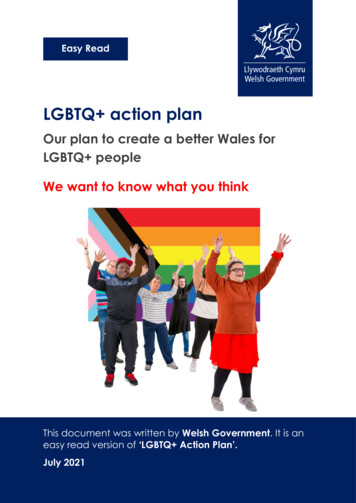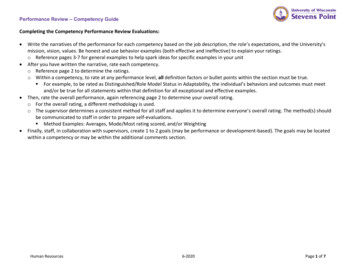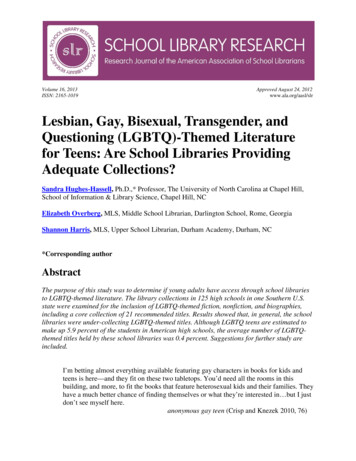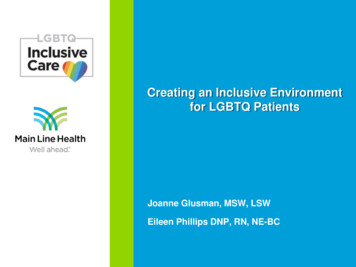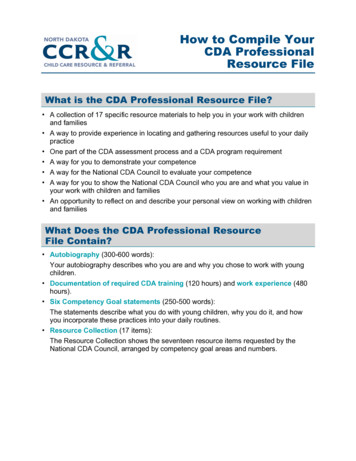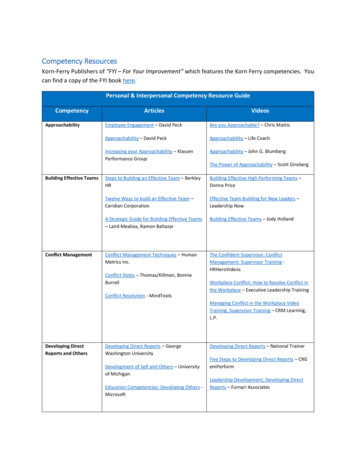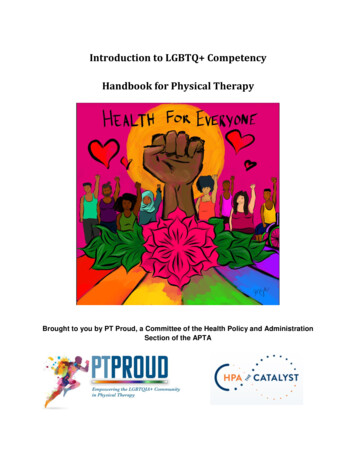
Transcription
Introduction to LGBTQ CompetencyHandbook for Physical TherapyBrought to you by PT Proud, a Committee of the Health Policy and AdministrationSection of the APTA
About the AuthorsPT Proud is the LGBTQ Catalyst Group/Committee of the Health Policy &Administration Section of the American Physical Therapy Association. It is an LGBTQ (lesbian, gay, bisexual, transgender, queer/questioning, ) advocacy group supportingequity, education, and community for LGBTQ patients and practitioners. Our mission isto unite PTs, PTAs, and students towards a common goal of affecting change in ourprofession through advocacy, policy, and promotion of competency education. We aimto address health disparities and positively affect the health care experience of LGBTQ patients, students, and clinicians.This handbook was written by members of PT Proud’s educational task force, whosegoal is to provide cultural competency education and to increase awareness of LGBTQ issues in physical therapy. We are physical therapy clinicians, educators, and studentswho care deeply about helping our profession in becoming increasingly competent andconfident in providing care to LGBTQ patients.Main authors: Felix Hill, SPTAJ Pluss, DPTKarla A. Bell, PT, DPTLindsay Fons, DPT, LATChris Condran PT, DPT, MBA-HCM, MS, EP-C, CCSJoin PT Proud:If you want to support work like this promoting LGBT cultural competency in physicaltherapy, please join PT Proud—an LGBTQ Catalyst Group through the APTA! It is freeand quick for all members of the HPA to join. Becoming a member allows us tocommunicate with you about events, resources and all other matters related to PT Proud!To join, follow these steps below. Become a member of the HPALog into your profile on the HPA website using your APTA member ID number and lastname (https://www.aptahpa.org/login.aspx)Click Manage ProfileClick Edit BioScroll down to the Additional Information sectionClick the dropdown for "Yes" beside the "LGBTQ Catalyst Group Member" categorySave changesFollow us on Facebook:https://www.facebook.com/PTProud/Find additional resources on our websitehttps://www.ptproud.orgAbout the Illustrator:Michael Zabala Aquino, PT, DPT is an orthopedic and pelvic health physical therapistfrom Los Angeles, CA. He is the owner and founder of Deconstruct Health PhysicalTherapy & Consulting PC, a private practice with a mission to improve representationand accessibility within health, wellness, and fitness through disrupting and dismantlingthe narrowly defined narrative of what healthy and fit means. Find out more about Dr.Aquino and Deconstruct Health at deconstructhealth.com or on social media:Instagram: deconstruct.healthFacebook: facebook.com/deconstruct.health2
Purpose of this HandbookOther handbooks aiming to educate clinicians on how to work competently withLGBTQ (also referred to as sexual and gender minority) patients already exist. Thishandbook is unique in that it is specific to the needs and concerns of physicaltherapists.In the first portion of this handbook, we discuss healthcare disparities faced by LGBTQ individuals and contextualize these disparities in the framework of systems ofoppression. We review the most up to date research that currently exists on physicaltherapists’ attitudes and competence in working with LGBTQ patients in order to raiseawareness of issues within our field.Finally, we introduce essential terms and concepts that the literature indicates areneeded to establish cultural competence when working with LGBTQ patients and offerrecommendations to create a safe and welcoming clinical environment. We discussinclusivity in intake forms and include a sample intake available for use in part or in full.Throughout the handbook, questions for reflection are included before each section.This is an introductory 101 level handbook. We have not included information on thefull spectrum of identities and experiences that make up the LGBTQ (sexual andgender minority) umbrella. We welcome your feedback to make this handbookoptimally inclusive, considering its introductory purpose. We also welcome suggestionsfor what content you would like to see in future versions.Ultimately, we hope this handbook will empower physical therapy clinicians to becomemore confident and culturally competent providers for LGBTQ patients, and to becomeadvocates for inclusivity and equality for all patients. Most importantly, we hope thishandbook will inspire you to continue to seek further information. A list of resources willbe provided, and you are welcome to become a PT Proud member and follow us onsocial media for ongoing education and news related to LGBTQ issues in physicaltherapy (information on joining is in the back of the handbook.2
Table of ContentsHealthcare Inequalities and LGBTQ Patients 4Understanding Inequalities: Systems of Oppression .6Physical Therapist Attitudes and Competence in Providing LGBTQ Care . 7Important Terms and Concepts for Clinicians .8Importance of Providing Trauma-Informed Care .16Inclusive Paperwork .20Questions for Reflection and Case Scenarios .233
Healthcare Inequalities and LGBTQ PatientsWhat are some ways that one’s gender or sexual identity could affect the care they aregiven by health care professionals?Research related to healthcare disparities experienced by LGBTQ identifying patientsare limited.LGBTQ individuals experience significant rates of healthcare discrimination in the US.In Lambda Legal’s 2010 survey of LGBT people and people with HIV, “WhenHealthcare Isn’t Caring”1: Over 50% of LGB study participants reported one or more of the following: beingrefused care, having their healthcare provider refuse to touch them, excessiveuse of precautions when being treated, being blamed for their health status, orhaving their healthcare provider verbally abuse them. Transgender people reported having experienced discrimination and barriers toaccessing healthcare at as much as 2 to 3 times the rate experienced by LGBpeople. LGBT people of color and people of lower socioeconomic status were also morelikely to report facing discriminatory or substandard care.The 2015 U.S. Transgender Survey2, the largest survey to date examining theexperience of transgender individuals in the U.S, found: Of the respondents who saw a health care provider in the past year, 33% had atleast one negative experience related to being transgender. Negative experiences included being denied care, being harassed or assaulted,or having to educate their provider about what identifying as transgender meansto them and basics about the healthcare they are seeking in order to getappropriate care. 23 percent of respondents did not seek needed medical care in the past yearbecause they feared being mistreated as a transgender person, and 33 percentdid not seek care due to financial barriers.Lambda Legal’s 2009 Healthcare Fairness Survey found that within the LGBTcommunity, people of color experience disproportionate levels of healthcarediscrimination compared to those who are white or who are not transgender. 34
Understanding Inequalities: Systems of OppressionHave you seen or heard disparaging comments or actions against LGBTQ individualsat your school or clinic?Before we introduce the health disparities LGBTQ people experience, it is important tounderstand the factors that contribute to them. This requires an understanding of howLGBTQ people, like all marginalized groups, are impacted by systems of oppression.Oppression is “the systemic and pervasive nature of social inequality woven throughoutsocial institutions Oppression fuses institutional and systemic discrimination, personalbias, bigotry and social prejudice in a complex web of relationships and structures thatsaturate most aspects of life in our society.”4 Institutional or systemic discriminationinclude laws and policies that marginalize or fail to offer equal protection to LGBTQ people. Individual prejudice, by contrast, occurs on an interpersonal level. This includesmicroaggressions, or subtle day to day interactions that communicate prejudice againstsomeone who is part of a marginalized group. It can sometimes escalate tointerpersonal violence. LGBTQ people frequently are the targets of stigma,discrimination and violence.5 Daily microaggressions lead to increased stress levels(sometimes referred to as minority stress) and thereby impact health.6Many LGBTQ people are also members of other marginalized groups. For example,LGBTQ individuals who are also people of color, of a low socioeconomic status, ordisabled will experience oppression in ways that reflect those identities as well, leadingto compounded experiences of oppression. Looking at this through the lens ofintersectionality allows us to understand how multiple identities all contribute to aperson’s health status. For more information about the intersectionality theoreticalframework, please see Lopez, Gadsden reference.7Given the impact of systemic oppression on LGBTQ health, there is a growingmovement to train healthcare professionals in “structural competency,” defined as “thecapacity for health professionals to recognize and respond to health and illness as thedownstream effects of broad social, political, and economic structures”.8 Within this lens,we see that the oppression LGBTQ individuals face - disproportionately so for peopleof multiple marginalized identities - negatively impacts quality of life and health, beyondindividual health decisions/behaviors.Health DisparitiesThe following are just a few of the most notable health related disparities LGBTQ peopleface, as reported in 2011 by the Institute of Medicine5: LGB youth are at higher risk for suicidal ideation, suicide attempts, anddepression A disproportionate number of LGB youth are homeless Lesbians and bisexual women may have a higher risk of obesity and breastcancer than heterosexual women, and be less likely to receive preventative care5
Men who have sex with men (disproportionately affected are black and Latinomen) are still disproportionately impacted by HIV/AIDS LGB adults may have higher rates of smoking, alcohol use, and substance usethan heterosexual adults (most of this research was conducted on women). Limited research indicates substance use is a concern for the transgenderpopulation as well. See the report: -on-coverage-and-access-to-care/Physical Therapist Attitudes and Competence in ProvidingLGBTQ Care:How comfortable do you feel when knowingly working with an LGBTQ client?How do your personal background or beliefs influence how you feel when working withan LGBTQ patient, if at all?Research related to LGBTQ experiences in conjunction with physical therapy isespecially limited. To our knowledge, a 2008 article by Burch is the only publishedstudy on PT attitudes toward LGBT people to date.9 Researchers surveyed 402providers working with patients with spinal cord injuries before and after administeringan LGBT competency training video. Participants included nurses, PTs, OTs, SLPs,PTAs, and OTAs. Prior to a brief cultural competency training video, physical therapistsreported significantly less respect for LGBT patients than nurses, and participant acrossthe board had limited knowledge about treating LGBT patients: 85% of PT’s and PTA’s reported tolerance versus respect for LGBT patients andonly 1% reported “full respect”. In contrast, 40% of nurses reported “some respect” while 44% of nurses reported“full respect”. 68% of respondents reported “very low to average knowledge” related to treatingLGBT patients.The results of this study would suggest that the field of physical therapy has a lot ofroom to grow in providing LGBT inclusive care.In 2016, Copti et al published a first of its kind position paper in the Journal of PhysicalTherapy Education titled: Lesbian, Gay, Bisexual, and Transgender Inclusion inPhysical Therapy: Advocating for Cultural Competency in Physical Therapist EducationAcross the United States.10 This paper “provides recommendations to health careeducators for improving cultural competency and outcomes for patients who are LGBTQ6
as well as suggestions for creating an inclusive learning environment and climate forstudents who are LGBTQ.”The APTA and National Policies Relevant to LGBTQ Health CareAt the national level, the Trump administration created a division of the Department ofHealth and Human Services called the “Conscience and Religious Freedom Division” inJanuary 2018. In alignment with the mission of this division, a proposed rule,“Protecting Statutory Conscience Rights in Health Care; Delegations of Authority,” wasalso announced in January. This rule would protect the right of healthcare workers torefuse care on the basis of their religious or moral objections. Prior to the Trumpadministration’s policies and stances, the United States had been on a path to moreaffirmative and inclusive policies for equity in healthcare for sexual and genderminorities.The APTA took a strong stance against the Trump administration’s proposed rule. In aletter to the Department of Health and Human Services in March of 2018, APTApresident Sharon Dunn argued that the ruling contradicts physical therapists’ Code ofEthics and Guide for Professional Conduct. The APTA’s letter expresses concern thatthis rule could enable PT’s to put their personal beliefs in front of the needs of thepatient: “APTA has concerns that the rule, if implemented as proposed, couldundermine the ability of patients to receive the health care they need, particularly thosemost vulnerable”.11Important Terms and Concepts for CliniciansWhat is your gender and sexual orientation? Can you name any others?LGBTQ (Lesbian, Gay, Bisexual, Transgender, Questioning or Queer, Intersex,Asexual, ( all inclusive!)Coming out - Can include telling others how you identify. It is a very individual decisionif/when to come out. It is important not to “out” anyone (reveal their identity to others)without their permission (for many reasons, including safety.)Sexual OrientationSexual Orientation - Describes sexual attraction only, and is not directly related togender identity. The sexual orientation of transgender people should be defined by the7
individual. It is often described based on the lived gender; a transgender womanattracted to other women would be a lesbian, and a transgender man attracted to othermen would be a gay man.12Lesbian - Term used to describe female-identified people attracted romantically,erotically, and/or emotionally to other female-identified people.13Gay – 1. Term used in some cultural settings to represent males who are attracted tomales in a romantic, erotic and/or emotional sense. Not all men who engage in“homosexual behavior” identify as gay, and as such this label should be used withcaution. 2. An individually selected identity label for anyone who does not identify asheterosexual13Bisexual - A person who is physically and/or sexually attracted to more than onegender. This attraction does not have to be equally split between genders and theremay be a preference for one gender over others.13Queer - 1. An umbrella term which embraces a matrix of sexual preferences,orientations, and habits of the not-exclusively- heterosexual-and-monogamous majority2. This term is sometimes used as a sexual orientation label instead of ‘bisexual’ as away of acknowledging that there are more than two genders to be attracted to, or as away of stating a non-heterosexual orientation without having to state who they areattracted to. 3. A reclaimed word that was formerly used almost exclusively as a slur butthat has been semantically overturned by members of the maligned group, who use itas a term of defiant pride. For decades ‘queer’ was used solely as a derogatoryadjective for gays and lesbians, but in the 1980s the term began to be used by gay andlesbian activists as a term of self-identification. Eventually, it came to be used as anumbrella term that included gay men, lesbians, bisexuals, transgender persons, andpeople of other sexual orientations and gender identities. 13Asexual - Someone who does not experience sexual attraction, or who has a little or nointerest in sexual activity.IntersexIntersex Person - Someone whose sex assigned at birth is difficult for a doctor tocategorize as either male or female. A person whose combination of chromosomes,8
hormones, internal sex organs, gonads, and/or genitals differs from one of the twoexpected patterns.13Gender IdentityGender Identity - A person’s sense of being masculine, feminine, with another gender,or no gender in particular.13Sex - Has historically been referred to as sex assigned at birth, based on assessment ofexternal genitalia, as well as chromosomes and gonads. In everyday language is oftenused interchangeably with gender, however there are differences, which becomeimportant in the context of transgender people.12 Due to commonly being subdividedinto ‘male’ and ‘female’, this category does not recognize the existence of intersexbodies.13Transgender - A person whose gender identity differs from the sex that was assigned atbirth. May be abbreviated to trans. A transgender man is someone with a male genderidentity and a female birth assigned sex; a transgender woman is someone with afemale gender identity and a male birth assigned sex. A non-transgender person maybe referred to as cisgender (cis same side in Latin).12Gender expression - The outward manner in which an individual expresses or displaystheir gender. This may include choices in clothing and hairstyle, or speech andmannerisms. Gender identity and gender expression may differ; for example a woman(transgender or non-transgender) may have an androgynous appearance, or a man(transgender or non-transgender) may have a feminine form of self-expression.12Gender non-conforming (GNC) - umbrella term for anyone whose gender expressiondoes not match societal expectation.13 (Similar term: Gender Variant)Gender Binary – The idea that there are only two genders – male/female or man/womanand that a person must be strictly gendered as either/or.13Genderqueer – A gender variant person whose gender identity is neither male norfemale, is between or beyond genders, or is some combination of genders. Can includea political agenda to challenge gender stereotypes and the gender binary system.13(Similar term: Non-Binary)Non-binary - Similar to “genderqueer.”9
Non-binary gender pronouns such as they/them and ze/hir are often, but notalways used by non-binary, genderqueer, agender, and other gender variantindividuals as an alternative to the gendered pronouns she/her or he/him.Gender fluid - Someone whose gender varies over time13Agender - Someone without gender13Cross dresser / drag queen / drag king - These terms generally refer to those who maywear the clothing of a gender that differs from the sex which they were assigned at birthfor entertainment, self-expression, or sexual pleasure. Some cross dressers and peoplewho dress in drag may exhibit an overlap with components of a transgender identity.The term transvestite is no longer used in the English language and is consideredpejorative.12Two-Spirited - People within native cultures who are considered a third gender and whosee the world through the eyes of both men and women.Gender dysphoria - a sense of dissonance, which can cause psychological distress,between a person’s gender identity and how they are perceived. Many, but not all,trans people experience this. The experience of gender dysphoria motivates somepeople to transition.Gender TransitionMany, but not all transgender people, take steps to affirm their gender identity. Thismay or may not include changing one’s style of dress, hair, or make-up, and/orchanging one’s name and gender markers on identity documents. A person may alsofeminize or masculinize their body by undergoing hormone therapy (this is the primarymedical intervention sought by transgender people) and/or choose from a variety ofgender affirming surgeries. Hormones and surgery can be effective in relieving genderdysphoria and are medically necessary for many people. Additional steps may includehair removal, voice therapy, and practices such as breast binding or padding, genitaltucking or penile prosthesis.12For many transgender and gender non-conforming people, gender transition is a deeplypersonal matter. For this reason, it is important to refrain from asking questions out ofcuriosity. However, sometimes it is important to ask questions that are pertinent to10
care. The following are scenarios and examples of questions that would be appropriate,and even important to ask:-Your patient is a transgender man who presents with thoracic pain and whowears a chest binder (a a tight undergarment that is used to compress breasttissue, creating the appearance of a flat chest).- You ask how long they have been wearing the binder, and for how manyhours per day, as well as whether they notice any pain or shortness ofbreath when wearing it.- Your patient is a transgender woman with lower back pain. She notes on herchart that she has undergone vaginoplasty within the past year.- You ask about her recovery from that surgery and whether she has hadany related complications.- Your patient is a teenager with a sports injury who experiences depression.They mention to you that they have “questions about their gender” that aregetting them down.- You listen actively and invite them to tell you more about this, and askwhat kind of support they have access to in working through thesequestions. If they indicate they could use more support, you offer to referthem a mental health professional and/or gender related support group.You should not share this information with the patient’s parents orgaurdians without the consent of the patient.Gender Transition - definitions:Binder - A tight undergarment that is used to compress breast tissue, creating theappearance of a flat chest.Gender Confirmation Surgery or “Bottom Surgery” - Formerly called a sex change, thenSexual Reassignment Surgery. Also called Gender Affirmation Surgery. A variety ofsurgical approaches can be used, which may involve a graft. Some PT’s who specializein pelvic health may work with these patients pre- or post-surgery.Top Surgery - This term usually refers to surgery for the construction of a male-typechest, but may also refer to breast augmentation.13For more information on transgender surgeries, as well as the medical impact of othertransitions related practices, please see http://transhealth.ucsf.edu/protocols.11
Terms to AvoidTrannie - A slur referring to transgender people that is offensive, but is being reclaimedby some. To be respectful, do not use this term.Transsexual - A term used in reference to transgender people which is now largelyviewed as outdated and offensive. Parts of the transgender community, particularlyolder trans people, may still use this term to affirm their identity.13Transvestite - Someone who dresses in clothing generally identified with a differentgender. While the terms ‘homosexual’ and ‘transvestite’ have been used synonymously,they are in fact signify two different groups. The majority of transvestites areheterosexual males who derive pleasure from dressing in “women’s clothing”. (Thepreferred term is ‘cross-dresser,’ but the term ‘transvestite’ is still used in a positivesense in England).13Hermaphrodite - An out-of-date and offensive term for an intersex person. (See‘Intersex Person’).13Tips to build a trusting therapeutic relationship with LGBTQ patients:- Confidentiality. It is vital to avoid “outing” your patient to their family, friends, toyour own colleagues, or to anyone else. “Outing” means letting other peopleknow that your patient is LGBT, or divulging the patient’s specificidentity/identities without the patient’s consent.- Do not assume someone’s partner is the opposite sex/gender. Instead, listen tohow your patient describes their significant other, and use the same languagethey are using (pronouns as well as whether they call this person theirpartner/spouse/husband/wife/sweetheart etc.). If you are unsure, use a genderneutral word like partner or spouse at first.- Listen to how the patient identifies and use the same language. For example, ifthey say they are gay, do not use the word “homosexual” or “queer”.- Recognize the diversity of sexual practices. If your patient’s sexual practices areaffected by their impairments and this comes up as part of their care, be nonjudgemental and ask open-ended questions. Avoid making any assumptionsabout what sex means to them or what kind of sex they are having.- Understand there is no one way for transgender or gender variant people totransition. Your patient may or may not have undergone steps to medicallytransition. However, they also may not have, and may or may not want to do soin the future. They may start transitioning early or late in life. If your patient has12
--been or is undergoing some kind of gender transition, avoid making anyassumptions about what your patient’s transition might involve.Best Judgement. If your patient has had gender confirmation surgeries or istaking hormones, you may not know unless you ask, as not everyone will feelcomfortable including this information on a general intake form. Use your bestjudgement and only ask questions related to medical transition in a sensitivemanner when this information is important for to provide quality patient care.Necessity not curiosity. It should go without saying that we should never askabout any patient’s body or sexuality out of curiosity. It is important to askquestions only when that information is clearly relevant to allow you to providethe best possible care. If you create a safe space, this will allow your patient tofeel comfortable opening up to you about their experiences, should they wish to.Office Policies and Practices are vital to create a safe space for LGBTQ patients:- Names and Pronouns- Make your paperwork inclusive! Please see our section on paperwork formore information, and feel free to use our sample paperwork as a model.Patients should be able to provide their preferred name, pronouns, andgender identity. Ideally this information should be represented onelectronic medical records so all staff can address the patient respectfully.- You cannot tell someone’s gender by the way they look or sound, or bytheir name. This is true of everyone, not just transgender and gendernon-conforming people. For this reason, avoid using gendered terms orpronouns unless you are sure of someone’s gender identity and preferredpronouns. For example, avoid saying Mrs., Ms., Mr., ma’am or sir. Alsoavoid using pronouns such as she/her and he/him when describing thepatient to other staff members until you know what pronouns someoneuses. More information on how to obtain someone’s preferred name andpronouns can be found in the section on pronouns.- Working with Transgender People’s Bodies- Is the same as working with anyone else’s body! However, don’t makeassumptions about someone’s body, such as what genitals someone has(if you are doing pelvic floor work, or working near the groin) or whetherthey have breasts (some people’s chest may appear to be flat due to theuse of a chest binder).- Avoid expressing surprise or judgement.- Some terms for body parts may bring up discomfort in your patient, relatedto gender dysphoria. Follow their lead by listening to the language theyuse to describe a part of their body, or simply ask the patient how theywould like you to refer to a potentially sensitive area.13
---Let the patient determine what makes them comfortable in the session.For example, you may find that a transgender woman wears a scarf overher head or a wig because she is uncomfortable showing a recedinghairline; or that a transgender man wears a binder to flatten his chest. Ineither case, do not express surprise or judgement. Make it clear that it isfine for them to keep the scarf or binder on during the session. You mayalways explain the benefits of removing a piece of clothing if it’s relevantto your treatment, but the decision should be fully up to them and thereshould be no sense of pressure to take remove the item/s. This should beapplied to any patient (transgender or otherwise) who does not feelcomfortable removing any article of clothing.Marketing & Educational Materials- Make sure your marketing and educational materials represent peoplewho are LGBTQ , as well people of color and people with disabilities, sothat all people feel welcome in your clinic. If you have pregnancy relatedresources, consider that these should include images of transmasculinepregnant people as well as cisgender women.- Make a statement on your website and marketing materials that the clinicis a safe and welcoming space for LGBTQ individuals, and/or include apublicly displayed non-discrimination statement that includesdiscrimination based on gender and sexual orientation. However,consider whether your clinic truly is a safe space before posting thesestatements. For example, if there are no all-gender bathrooms(bathrooms in which people of all genders are welcome), it is not fully asafe space. In this case, you can state that your clinic is welcoming, whilealso making a statement describing any conditions that are suboptimal. Ifyou are working to remedy the situation, by all means, say so!- Consider wearing a rainbow lanyard or posting a rainbow stickersomewhere prominent as a visual signal that this is a safe space.Bathrooms- Mark bathrooms as “all gender” bathrooms. “All gender” means thatpeople of any gender are welcome to use it. If this is not possible
If you want to support work like this promoting LGBT cultural competency in physical therapy, please join PT Proud—an LGBTQ Catalyst Group through the APTA! It is free and quick for all members of the HPA to join. Becoming a member allows us to communicate with you about eve
